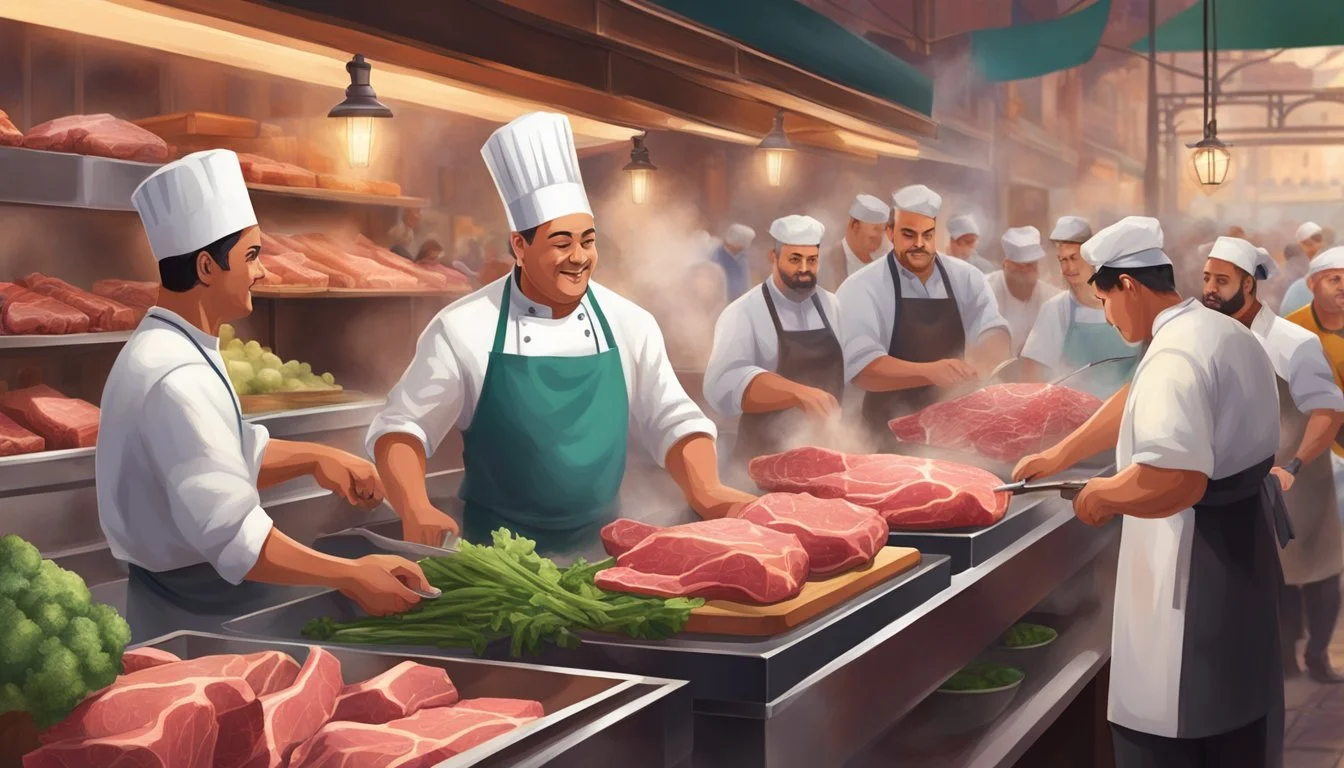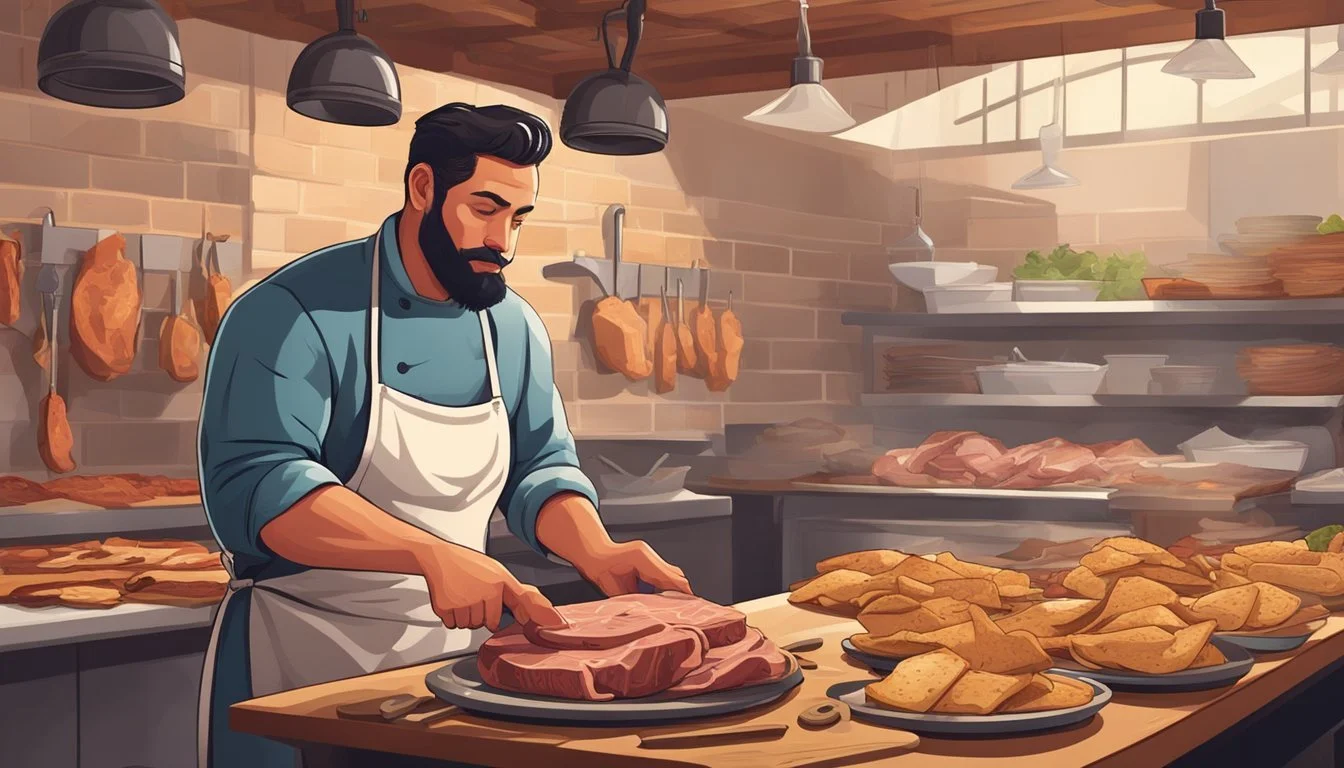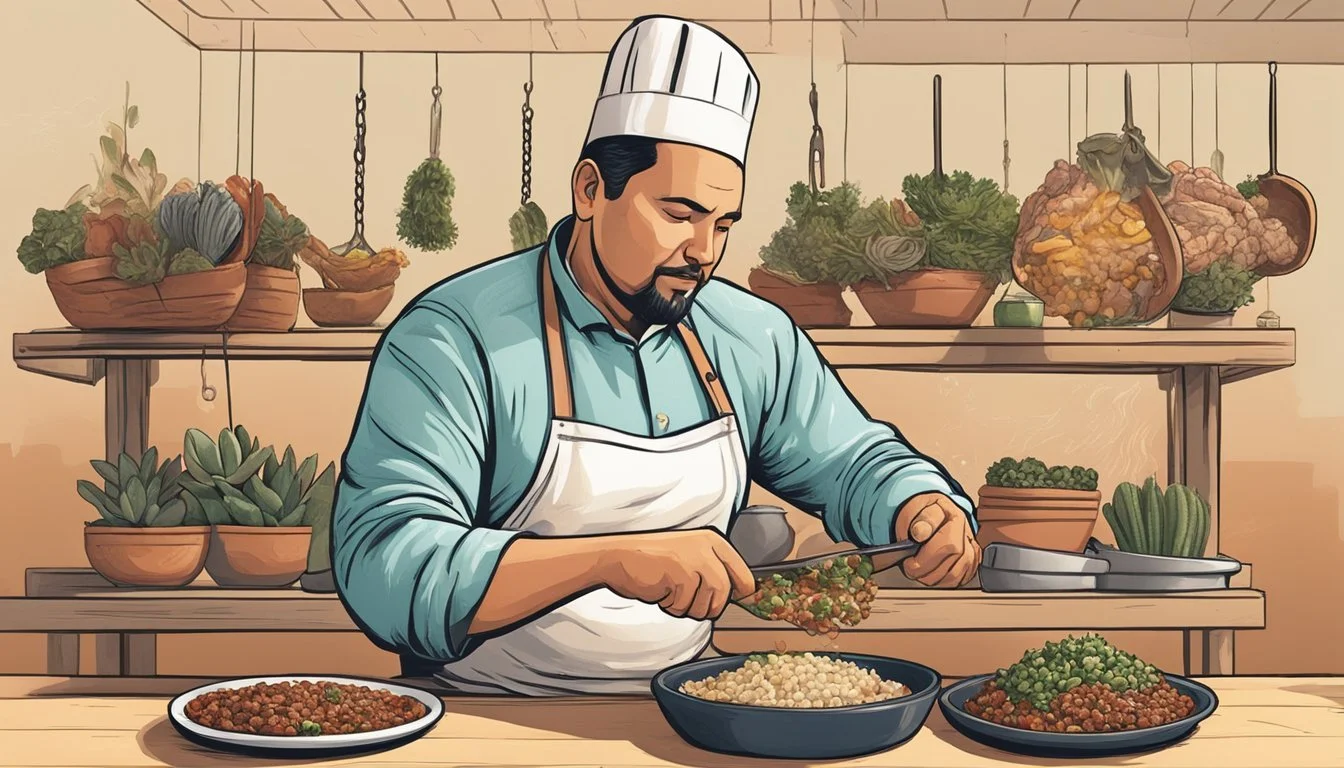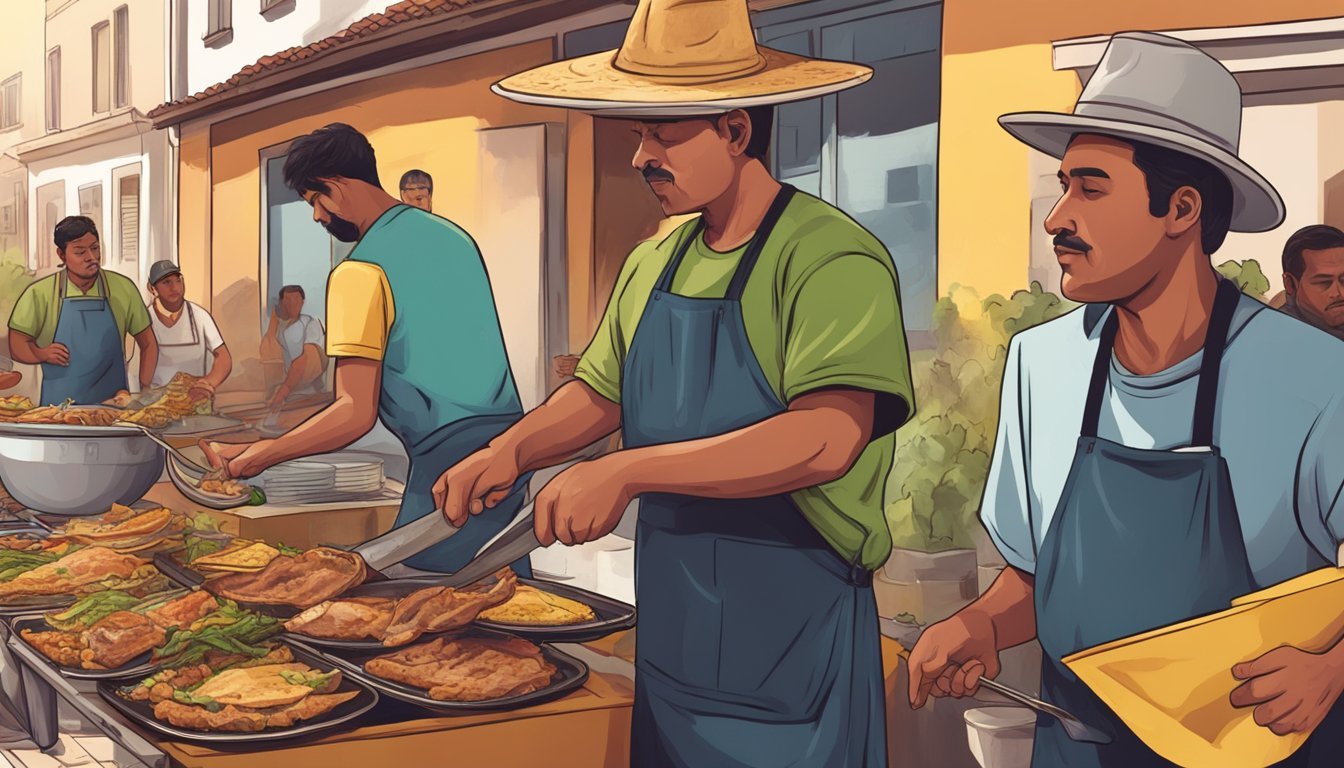The Tradition of Tacos de Cabeza
An Insight into Mexico's Culinary Heritage
Tacos de cabeza, a prized street food staple in Mexico, exemplify the country's cherished culinary traditions. Originating from humble beginnings, this dish leverages every part of a cow's head, transforming it into a delicacy savored by many. In the bustling streets of Mexico City, one can witness the skilled preparation of the head meat which involves steaming it until tender. This meticulous process ensures that the flavors are concentrated and the meat is succulent.
The assembled taco is a symphony of textures and tastes, featuring a soft tortilla cradling the steamed meat, garnished with finely chopped onions, cilantro, and a splash of vibrant salsa. Patrons at these street-side eateries are often presented with a choice of specific head meats, such as brain, ear, or tongue, each offering a unique flavor and a different window into the rich tapestry of Mexican cuisine.
Celebrated for its authenticity and rich flavors, tacos de cabeza are more than just a meal; they are a testament to Mexico's cultural heritage and culinary ingenuity. Whether it's a breakfast on the go or a late-night snack, these head tacos embody the essence of Mexican street food—accessible, delicious, and deeply rooted in tradition.
History and Cultural Significance
Exploring the roots of Tacos de Cabeza reveals their deep-seated role in the traditional culinary landscape of Mexico, reflecting both a rich history and a vibrant street food culture with an enduring love for this particular style of taco.
Origins of Tacos de Cabeza
Tacos de Cabeza can trace their origins back to Mexico's pre-Columbian era, evolving over time to incorporate various meats following the introduction of livestock by Spanish colonizers. As a traditional Mexican dish, they embody the resourcefulness of Mexican cooks to utilize the entirety of an animal, thus minimizing waste. The preparation of Tacos de Cabeza became a unique gastronomic technique that honored the animal by making use of the head meat.
Tacos de Cabeza in Mexican Cuisine
A staple in Mexican cuisine, Tacos de Cabeza is especially beloved in urban settings such as Mexico City, as well as in regions like Sonora and the Bajío area. These tacos have gained a reputation for showcasing the rich and authentic flavors of Mexico, often including a variety of head meats such as tongue, cheek, eyes, and lips, which are esteemed for their texture and taste.
Tacos de Cabeza and Mexico's Street Food Culture
Tacos de Cabeza are a quintessential element of Mexico's vibrant street food culture. Vendors offer these tacos with an array of condiments, including freshly chopped onions, coriander, and a selection of red or green salsas, which customers can tailor to their own preference. The enjoyment of Tacos de Cabeza from a busy street vendor encapsulates the communal and accessible nature of Mexican street food, where traditional flavors meet the hustle and bustle of everyday life.
Ingredients and Preparation
Tacos de Cabeza are a testament to the resourcefulness and flavor-rich traditions of Mexican cuisine, utilizing slow-cooked meat from a cow's head served on soft corn tortillas. This section delves into the pivotal ingredients and traditional cooking methods characteristic of this dish.
Key Ingredients for Tacos de Cabeza
Meat: The star of these tacos is the cabeza, specifically the beef cheeks, which are known for their succulence.
Tortillas: Small, pliable corn tortillas are the traditional choice, providing a robust flavor and texture.
Seasonings: Typical seasonings include salt and pepper for the meat, and lime wedges are served on the side to enhance the flavors.
Salsa: A variety of salsas offer a spicy kick that complements the richness of the meat.
Traditional Cooking Methods
The cooking process is a slow simmer for several hours, allowing the meat to become exceptionally tender and flavorful. Here's a traditional method commonly used:
Beef cheeks are seasoned with salt and pepper and placed in a large pot or slow cooker.
Aromatic ingredients like onions and bay leaves are often added alongside the meat for additional flavor.
The cooker is filled with water, then covered, and the meat is left to cook over low heat.
Once fork-tender, the beef cheeks are carefully pulled apart and unwanted parts are discarded.
The meat is then chopped and served on warm corn tortillas, often garnished with lime, salsa, and other toppings as desired.
The Anatomy of Tacos de Cabeza
Tacos de Cabeza are a complex and traditional Mexican dish that feature various parts of an animal's head, most commonly beef or goat, to create a rich, flavorful experience enhanced by a variety of toppings.
Understanding Tacos de Cabeza Components
The core ingredient of Tacos de Cabeza is the meat from an animal's head, which is meticulously prepared and typically steamed or boiled until tender. The most commonly used meats include:
Beef: Parts of the cow's head, notably the cheeks and sometimes even the brains and tongue, are used.
Goat: Similarly, goat meat from the head can be utilized in making tacos de cabeza.
The meat is carefully chopped up after cooking. The cooking process ensures that the natural flavors and textures of the various parts of the head are retained and enhanced. It's worth noting that beef tongue, or 'lengua,' is particularly prized for its tenderness and taste.
The Role of Toppings in Flavor
Toppings are crucial in crafting the final taste profile of Tacos de Cabeza. Here's a breakdown of typical toppings and their roles:
Onions: Often chopped and raw, they introduce a sharp, crisp contrast to the rich meat.
Cilantro: Fresh and citrusy, cilantro adds a herbaceous freshness.
Salsas: Red or green, salsas infuse the tacos with heat and acidity, complementing the savory meat.
Cheese: Occasionally, cheese may be used to add a creamy texture and balance the strong flavors of the meat and salsas.
These components combine harmoniously, allowing for a rich interplay of flavors and textures that have cemented Tacos de Cabeza as a beloved Mexican street food tradition.
Variations and Related Dishes
In exploring the rich tapestry of traditional Mexican cuisine, one will find that Tacos de Cabeza is but one expression among many related and regionally-distinct taco varieties, each offering a unique twist on this classic dish.
Regional Variations of Tacos de Cabeza
Regional variations of Tacos de Cabeza can vary significantly, reflecting local traditions and available ingredients. In some regions, tacos de lengua (tongue tacos) are especially prized for their tender texture. Another variety includes tacos de ojo (eye tacos), which are less common but featured in some local eateries.
Barbacoa, traditionally slow-cooked lamb or goat meat, also finds its way into tacos, offering a distinct, smoky flavor. While barbacoa can refer to cooking meat in an underground oven, many Mexican states have their own take on the dish, some using beef head as well. For instance, in the state of Hidalgo, barbacoa is often prepared with sheep and served with consomme, while Tacos de Barbacoa may use cow's head in other regions.
Similar Taco Styles
Mexican cuisine boasts a wide array of other taco styles that, while different from Tacos de Cabeza, share a common heritage. Carnitas, braised or simmered pork, is a beloved filling in many regions. Suadero, a cut between the belly and the leg of the cow, offers a unique flavor and tenderness desirable in tacos.
Tacos al pastor, which feature thin slices of pork that have been marinated in a combination of spices, chiles, and pineapple, then cooked on a vertical rotisserie, provide a sweet and spicy experience. Tacos de Chicharron, filled with fried pork rinds simmered in salsa, present a crunchy texture and a robust taste. Cochinita Pibil, a slow-roasted pork dish from the Yucatán Peninsula, is marinated in citrus and annatto seed, and it’s often served in tacos with pickled onions.
Other popular fillings include cecina (salted and dried beef or pork), chorizo (spicy sausage), and even non-meat alternatives like mole with chicken. Each variety showcases the diversity and creativity embedded in Mexican culinary traditions, where even simple dishes like tacos offer an endless spectrum of flavors and textures.
Nutritional Information
Tacos de Cabeza are a rich source of nutrients, offering a balance of protein, fat, and carbohydrates when considering the meat and typical taco accompaniments. These tacos can support a balanced diet when consumed in moderation.
Health Considerations of Tacos de Cabeza
The meat used in Tacos de Cabeza predominantly comes from a cow’s head and may include various parts such as the cheek. This meat is known for being high in protein, which is essential for muscle repair and growth. Consuming protein also helps with satiety, which can aid in managing hunger and potentially support weight maintenance efforts.
The beef in these tacos is also a source of B vitamins, specifically B12, important for brain health and energy levels, and iron, which is crucial for oxygen transport in the blood. However, individuals should be aware that the meat can be high in saturated fat, depending on the preparation and the specific parts of the head used.
Caloric content can vary widely with Tacos de Cabeza, especially based on portion size and the addition of toppings like cheese, sour cream, or avocado. These additions increase the caloric intake and can add significant amounts of fat. When considering the health impact, one should monitor serving sizes and topping choices to manage their dietary needs effectively.
A common concern when consuming Tacos de Cabeza is the potential for a high sodium content, especially when seasonings or prepared condiments are added. A diet high in sodium can be linked to increased blood pressure and cardiovascular issues.
In summary, Tacos de Cabeza can be both nutritious and indulgent. They are a source of essential nutrients like protein and iron but can also contain high amounts of saturated fats and sodium. It is beneficial for individuals to consider these factors and balance them with their overall dietary goals.
Cooking Tips and Tricks
When preparing Tacos de Cabeza, understanding the cooking techniques and the use of proper equipment is instrumental in honoring this traditional dish.
Expert Advice on Preparing Tacos de Cabeza
For a successful preparation of Tacos de Cabeza, the selection of meats such as beef cheeks and lips is essential. They should be marinated with a blend of spices including cumin and oregano to enhance the flavor. Prior to cooking, it’s crucial to let the meat marinate for several hours, if not overnight, to ensure the flavors are well-absorbed.
Braising is a key technique used during the cooking process. Cooks should place the seasoned head in a pot large enough to accommodate it fully. Covering the head with water, this method involves cooking the meat at a low temperature for an extended time, typically around 8 hours, until it is extremely tender. This slow cooking process can be done in either a conventional oven or a slow cooker, and it's this low and slow braising that helps develop a deep, rich taste.
The type of pot also impacts the outcome. A Dutch oven is often recommended for its ability to retain heat and distribute it evenly, successfully tenderizing the meat while keeping it moist. If opting for a more traditional approach, a grill can also be employed. In this case, one should grill the marinated head covered in banana leaves or foil, maintaining a low temperature for several hours. This method infuses the meat with a subtly grilled flavor that can add complexity to the dish.
When it comes to serving, tortillas are a pivotal element. They must be soft and warm, which enhances the overall texture and taste of the taco. Corn tortillas are the traditional choice and can be quickly heated on a grill or a hot skillet for a few seconds per side to make them pliable.
Finally, the addition of salsa can bring a vibrant kick to Tacos de Cabeza. Freshly made salsa, whether it be a simple pico de gallo or a more complex salsa verde, adds freshness and heat, delighting the palate with every bite.
Tacos de Cabeza in Modern Cuisine
Tacos de Cabeza, a staple in Mexican street food, has evolved to become an essential offering in contemporary Mexican restaurants, influencing global taco trends.
Tacos de Cabeza in Contemporary Mexican Restaurants
In the bustling streets of Mexico City and across other regions, Tacos de Cabeza has moved from the road-side stands to the menus of modern Mexican eateries. Chefs in these restaurants are adding a gourmet twist to this traditional dish while maintaining its authentic flavors. They often serve Tacos de Cabeza with an array of freshly made salsas, and diners can opt for specific meat cuts from the cow's head, such as cheek or tongue, known for their tenderness and depth of flavor.
Influence on Global Taco Trends
The global culinary scene has embraced Tacos de Cabeza, with international taco restaurants incorporating this dish to bring an authentic Mexican experience to their customers. Whilst still being aligned with traditional methods, the preparation sometimes adapts to use local ingredients or modern cooking techniques like slow-cooking to achieve the same fall-apart tenderness. This global interest has positioned Tacos de Cabeza not just as a traditional plate but also as a contemporary trend within Mexican cuisine.
Sustainability and Ethical Considerations
When discussing Tacos de Cabeza, it is imperative to consider the ethical and sustainability aspects involved with this culinary tradition. These considerations encompass both the welfare of the animals used and the broader environmental impact of meat consumption.
Tacos de Cabeza and Animal Welfare
Tacos de Cabeza require the use of various parts of an animal's head, a practice that can promote nose-to-tail consumption, potentially reducing waste. However, this doesn't automatically imply humane treatment of livestock. Animal welfare is a crucial aspect, and it mandates that animals be raised and slaughtered under conditions that minimize distress and discomfort. Ethical considerations extend to ensuring that the animals receive:
Adequate space
Proper nutrition
Good health management
Humane slaughtering techniques
Adherence to these principles is essential for ethical carnivorous practices, including tacos de cabeza.
Environmental Impact of Meat Consumption
The production of meat, including the parts used in making Tacos de Cabeza, has a significant environmental impact. Meat consumption contributes to:
Higher water usage
Increased greenhouse gas emissions
Land degradation
Reducing meat consumption is often recommended as a way to mitigate these environmental issues. Those who produce and consume Tacos de Cabeza can contribute to sustainability by:
Supporting local, sustainable farming practices
Using all parts of the animal to reduce waste
Moderating consumption to lower the demand for intensive livestock farming
Addressing these environmental concerns is critical for maintaining the balance between cultural culinary traditions and the health of our planet.
Conclusion
Tacos de cabeza hold a significant place within Mexico's culinary heritage. These traditional head tacos showcase the resourcefulness embedded within the culture, fully utilizing an animal's parts that might otherwise be discarded. In preparing tacos de cabeza, the head of a cow or sometimes a pig or sheep is expertly boiled until the meat is tender and easily separated from the bone.
During the cooking process, flavors are often enhanced with the addition of lard or vegetable oil, ensuring a rich taste. Considered a delicacy, preparing and consuming tacos de cabeza is not just about sustenance, but rather a celebration of cultural history and culinary craftsmanship.
In contemporary settings, while traditional methods may be upheld, one also finds innovation, with chefs injecting personal twists into their recipes while respecting the dish’s origins. Consumers express their love for this dish across Mexico, as reflected in the statistics of beef consumption, and it remains a staple in local diets and food festivities.
The popularity of tacos de cabeza transcends borders, with its savory appeal winning over palates in various parts of the world, demonstrating the fluidity of food traditions and the integral role they play in the ongoing narrative of cultural identity.





